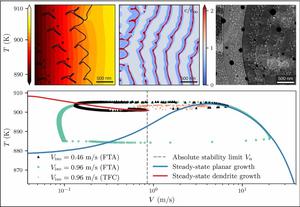合金快速凝固过程中的微观结构发展
IF 5.5
3区 材料科学
Q2 CHEMISTRY, PHYSICAL
引用次数: 0
摘要
结构合金的凝固加工可在极宽的固液界面速度范围内进行,速度跨越六个数量级,从微米/秒的低速宪法过冷极限到米/秒的高速绝对稳定极限。在这两个极限之间,固液界面在形态上并不稳定,通常会形成蜂窝状树枝状微结构,但也会形成其他难以捉摸的微结构。增材制造技术的快速发展再次激发了人们对高速范围建模的兴趣,而近似分析理论对高速范围的预测有限。在本文中,我们将讨论金属合金快速凝固相场建模的最新进展,包括简要介绍用于模型验证的最新实验。我们介绍了相场模型如何应对双重挑战:既要在与实验相关的长度和时间尺度上进行模拟,又要纳入在快速凝固时成为主导的固液界面非平衡效应。我们介绍了部分结果,说明相场模拟如何为高速界面动力学提供了前所未有的洞察力,为绝对稳定极限和带状微结构的形成提供了新的启示,而带状微结构是该极限附近合金快速凝固的标志。我们还讨论了用于验证这些见解的最新实验。本文章由计算机程序翻译,如有差异,请以英文原文为准。

Microstructure development during rapid alloy solidification
Solidification processing of structural alloys can take place over an extremely wide range of solid–liquid interface velocities spanning six orders of magnitude, from the low-velocity constitutional supercooling limit of microns/s to the high-velocity absolute stability limit of m/s. In between these two limits, the solid–liquid interface is morphologically unstable and typically forms cellular-dendritic microstructures, but also other microstructures that remain elusive. Rapid developments in additive manufacturing have renewed the interest in modeling the high-velocity range, where approximate analytical theories provide limited predictions. In this article, we discuss recent advances in phase-field modeling of rapid solidification of metallic alloys, including a brief description of state-of-the-art experiments used for model validation. We describe how phase-field models can cope with the dual challenge of carrying out simulations on experimentally relevant length- and time scales and incorporating nonequilibrium effects at the solid–liquid interface that become dominant at rapid rates. We present selected results, illustrating how phase-field simulations have yielded unprecedented insights into high-velocity interface dynamics, shedding new light on both the absolute stability limit and the formation of banded microstructures that are a hallmark of rapid alloy solidification near this limit. We also discuss state-of-the-art experiments used to validate those insights.
求助全文
通过发布文献求助,成功后即可免费获取论文全文。
去求助
来源期刊

ACS Applied Energy Materials
Materials Science-Materials Chemistry
CiteScore
10.30
自引率
6.20%
发文量
1368
期刊介绍:
ACS Applied Energy Materials is an interdisciplinary journal publishing original research covering all aspects of materials, engineering, chemistry, physics and biology relevant to energy conversion and storage. The journal is devoted to reports of new and original experimental and theoretical research of an applied nature that integrate knowledge in the areas of materials, engineering, physics, bioscience, and chemistry into important energy applications.
 求助内容:
求助内容: 应助结果提醒方式:
应助结果提醒方式:


